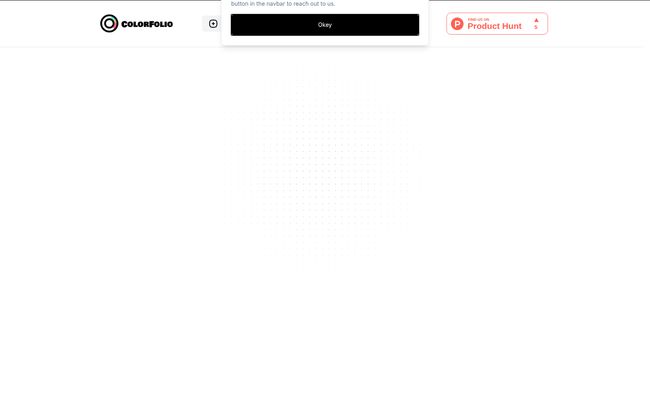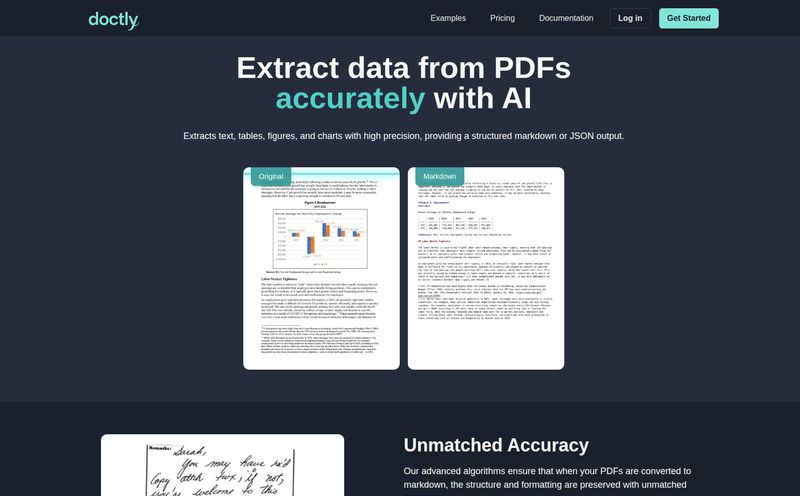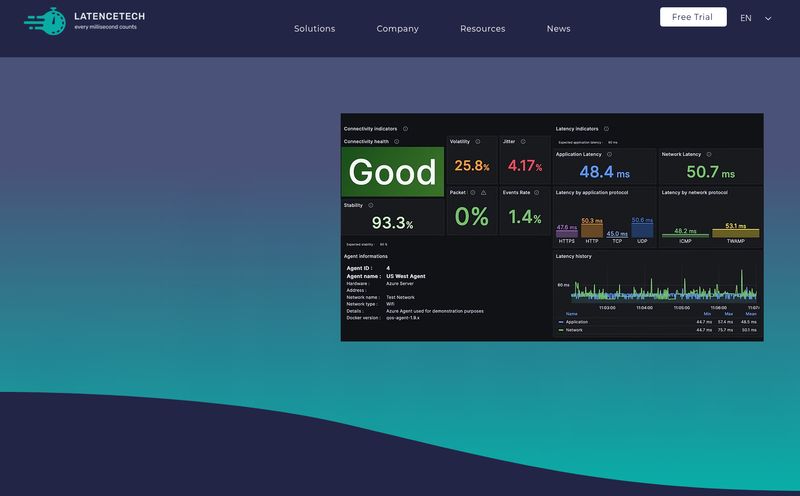I can't be the only one. You know the feeling. You’re staring at a blank canvas—a new website, a logo, a presentation deck—and you hit the wall. Not the writer's block wall, but its equally frustrating cousin: the color palette wall. You cycle through Adobe Color for the thousandth time, you spin the wheel on Coolors, you scroll endlessly through Pinterest boards titled "Color Inspo." Hours vanish. Your coffee gets cold. And you're left with fifty shades of beige that all somehow clash.
It’s a universal pain point for designers, marketers, developers, and anyone who has to make something look good. For years, we've relied on our own (sometimes questionable) taste, rigid color theory rules, and a handful of trusty generator tools. But what if you could just… ask for what you want? Like, with words?
That's the promise of a new tool that recently popped up on my radar: ColorFolio. It claims to be an AI-powered partner for generating unique color palettes from simple text prompts. Naturally, my curiosity got the best of me. An AI for colors? Sign me up. I had to see if it could save me from my next spiral into color-selection despair.
So, What Exactly is ColorFolio?
Let's get the basics out of the way. ColorFolio isn't just another random hex code generator. At its heart, it’s an intelligent system designed to interpret your creative vision, described in plain English, and translate it into a functional color scheme. Think of it less like a slot machine for colors and more like a conversation with a very speedy, art-savvy assistant.
You give it a prompt—something like, "a moody, dark academia library with hints of gold and aged paper" or "a vibrant, energetic fintech app for Gen Z"—and its AI gets to work. It spits out a palette that aims to capture that specific vibe. The idea is to bridge the gap between the feeling you want and the actual colors you need. It’s a pretty compelling concept, especially for branding projects where nailing the mood is everything.

Visit ColorFolio
My First Run-Through: A Walk in the Park
Hopping onto the ColorFolio site, the first thing I noticed was its clean, no-fuss interface. It's minimalist to the extreme, which I appreciate. There are no distracting pop-ups or confusing menus. Just a clear path to get started: Generate, Explore, Blog, Contact. Simple. A good sign.
As a seasoned pro in the digital marketing space, I’ve seen my share of overcomplicated tools that require a PhD to operate. This wasn't one of them. The learning curve is basically flat. If you can type a search into Google, you can use ColorFolio. This ease of use is a huge plus, removing any barrier to just jumping in and playing around, which is really the best way to get a feel for a creative tool.
Digging into the Core Features
Beneath the simple exterior, there are a few powerful ideas at play that make ColorFolio intriguing.
AI-Powered Prompting is the Star of the Show
This is the main event. The ability to use natural language to guide color selection is, frankly, a bit of a game-changer. It moves beyond just selecting a primary color and hoping the tool finds good complements. Instead, it taps into the vast network of associations we have with words and images.
I tried a few prompts to test its range:
- "A serene Japanese zen garden at dawn." It gave me soft grays, a misty green, a pale cherry-blossom pink, and a deep charcoal. Not bad at all.
- "A 1980s Miami neon sign at night." I got the hot pink, electric blue, and sunset orange I was hoping for. It totally understood the assignment.
- "Sustainable, organic skincare brand." This one produced a beautiful palette of earthy greens, off-whites, and a soft, clay-like terracotta.
The results weren't always perfect on the first try, but they were consistently a fantastic starting point, which is more than I can say for a lot of other methods.
Smart Suggestions and Endless Exploration
ColorFolio doesn't just hand you one palette and call it a day. It offers variations and allows you to explore similar themes. This turns it into a brainstorming partner. Maybe the first palette isn't quite right, but a color from a related suggestion is the exact shade you didn't know you needed. This feature encourages a more fluid, creative workflow rather than a rigid, one-and-done transaction.
A Nod to the Developers: Public API Access
Here’s something that made the techy side of my brain light up: the mention of a public API. For the non-developers in the room, an API (Application Programming Interface) allows different software to talk to each other. Having an API for ColorFolio means developers could potentially integrate this AI color generation directly into their own apps, websites, or design tools. Imagine a web design platform where you could type a description and have the entire site's theme update automatically. It shows the creators have bigger ambitions, and that's exciting.
The Good, The Bad, and The Beta
No tool is perfect, especially one that's new on the scene. So let's have a real chat about the highs and the lows from my experience.
The Upsides
I was genuinely impressed by the speed and creativity of the AI. It's like having a junior designer on call 24/7 who never gets tired of your weird requests. It breaks you out of your color ruts and forces you to consider combinations you might have otherwise overlooked. The sheer ease of use is another massive win. It’s an accessible tool for everyone, not just seasoned designers with a deep understanding of color theory.
The Caveats
Okay, let's be real. The platform is currently in beta. When I was poking around, I even hit a '404 page not found' error on one of the links, which is a classic sign of a product still under construction. This means you should expect some quirks, and maybe some features won't work exactly as planned just yet. Patience is a virtue here.
Secondly, you are putting your faith in the AI. While my tests were largely successful, an AI's interpretation can sometimes be… odd. It’s not a mind reader, and you might have to refine your prompts to get what you're truly looking for. It's a collaborator, not a magician.
What’s the Damage? The Pricing Question
This is the million-dollar question, isn't it? Or, hopefully, the ten-dollar-a-month question. As of right now, there is no public information on pricing or subscription tiers for ColorFolio. This is common for products in beta, as the creators are likely still figuring out their business model and gauging user interest.
My guess? We'll probably see a freemium model. Perhaps a free version with a limited number of generations per day, and a paid 'Pro' plan with unlimited access, palette saving features, and API credits. That’s the industry standard, but for now, it's pure speculation. My advice is to jump in and use it while it's likely free during this beta phase.
Frequently Asked Questions About ColorFolio
How does ColorFolio actually generate the colors?
It uses a form of artificial intelligence, likely a machine learning model trained on vast amounts of data—images, designs, and color palettes—to understand the relationships between words, concepts, and colors. When you enter a prompt, it analyzes the language and finds statistically likely color combinations that match that description.
Is ColorFolio free to use?
Currently, while it's in its beta testing phase, it appears to be free to use. However, the company has not released any official pricing details, so this could change in the future with the introduction of subscription plans.
Can I use the palettes for my commercial projects?
Generally, colors and color palettes themselves are not subject to copyright, so you can typically use the combinations in your work. However, it's always best practice to check the platform's Terms of Service for any specific restrictions on usage, especially for commercial purposes.
How does ColorFolio compare to other tools like Adobe Color?
Tools like Adobe Color are fantastic but are primarily based on traditional color theory rules (complementary, triadic, etc.) or extracting colors from an image. ColorFolio's main differentiator is its prompt-based, conceptual approach. It's less about the math of color harmony and more about the emotion and story of a color scheme.
Do I have to be a designer to use it?
Absolutely not! That's one of its biggest strengths. It's built for anyone—from professional UI/UX designers to startup founders, marketers, and students—who needs to create a compelling color scheme without getting bogged down in complex theory.
Final Verdict: Is ColorFolio Worth a Shot?
So, is ColorFolio the magic bullet for all our color-related woes? Maybe not a magic bullet, but it's a powerful and exciting new weapon for the arsenal. It represents a shift in how we can approach creative tasks, using AI not to replace our judgment, but to augment and accelerate it.
For anyone who has ever felt that familiar dread of an empty color picker, I'd say giving ColorFolio a try is a no-brainer. It’s fun, it's fast, and it just might spit out the perfect palette you've been looking for. It's still young and has some growing to do, but the foundation is solid and the potential is huge. I, for one, will be keeping a close eye on it. Go on, give it a whirl—what have you got to lose, except another afternoon of indecision?



